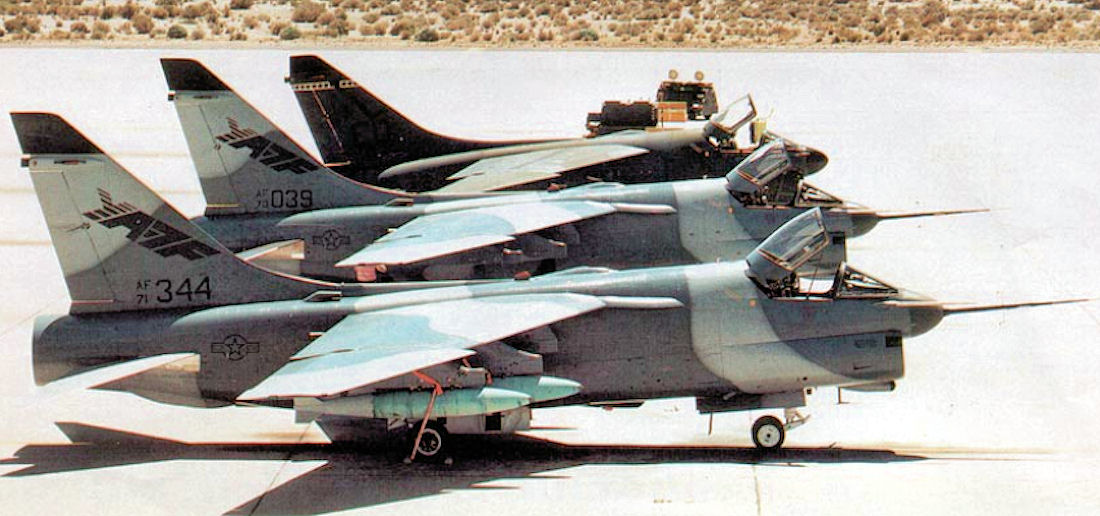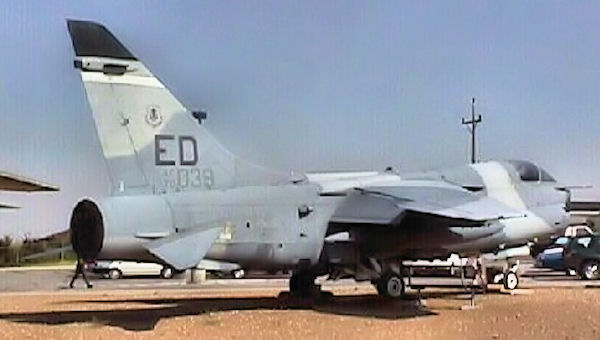Vought YA-7F on:
[Wikipedia]
[Google]
[Amazon]
The Vought YA-7F "Strikefighter" is a prototype transonic
 The vertical stabilizer height was increased about 10 in (25 cm), the unit horizontal tail was flipped from dihedral to anhedral, and control surfaces were flattened. The end result resembled the supersonic F-8 Crusader from which the original subsonic A-7 was derived. Many of the vehicle systems and mission systems were heavily modified and upgraded with leading edge technology, including a Molecular Sieve Oxygen Generating System and better cockpit displays. Low Altitude Night Attack Systems, an improved HUD and many software enhancements for navigation and weapons delivery were planned and being designed concurrently by Vought Dallas.
The new supersonic A-7 could accelerate with a bomb load from 400 to in under 15 seconds and could sustain Mach 1.2 for longer times with the extra fuel. The YA-7F modifications allowed 7-g turn and burn capability that permitted high-speed sustained evasive maneuvers plus great improvements in high angle of attack performance. As a CAS/BAI platform to penetrate into enemy territory and return safely, the "Strikefighter" moniker was most fitting. Two A-7Ds were extensively modified, the first one flying on 29 November 1989, and breaking the
The vertical stabilizer height was increased about 10 in (25 cm), the unit horizontal tail was flipped from dihedral to anhedral, and control surfaces were flattened. The end result resembled the supersonic F-8 Crusader from which the original subsonic A-7 was derived. Many of the vehicle systems and mission systems were heavily modified and upgraded with leading edge technology, including a Molecular Sieve Oxygen Generating System and better cockpit displays. Low Altitude Night Attack Systems, an improved HUD and many software enhancements for navigation and weapons delivery were planned and being designed concurrently by Vought Dallas.
The new supersonic A-7 could accelerate with a bomb load from 400 to in under 15 seconds and could sustain Mach 1.2 for longer times with the extra fuel. The YA-7F modifications allowed 7-g turn and burn capability that permitted high-speed sustained evasive maneuvers plus great improvements in high angle of attack performance. As a CAS/BAI platform to penetrate into enemy territory and return safely, the "Strikefighter" moniker was most fitting. Two A-7Ds were extensively modified, the first one flying on 29 November 1989, and breaking the

 ;YA-7F (A-7D Plus / A-7 Strikefighter)
:Stretched, supersonic version of A-7 powered by a
;YA-7F (A-7D Plus / A-7 Strikefighter)
:Stretched, supersonic version of A-7 powered by a
"YA-7F Strikefighter/70-1039."
''Air Force Flight Test Center Museum.'' Retrieved: 26 January 2022.
Wings of Eagles
YA-7F Prototype at Hill AFB Museum
* Joe Baugher's website on th
{{US attack aircraft A-7F Strikefighter 1980s United States attack aircraft Single-engined jet aircraft High-wing aircraft Cancelled military aircraft projects of the United States Aircraft first flown in 1989 Aircraft with retractable tricycle landing gear
attack aircraft
An attack aircraft, strike aircraft, or attack bomber is a tactical military aircraft that has a primary role of carrying out airstrikes with greater precision than bombers, and is prepared to encounter strong low-level air defenses while pr ...
based on the subsonic A-7 Corsair II. Two prototypes were converted from A-7Ds. The YA-7F was not ordered into production, its intended role being filled by the F-16 Fighting Falcon
The General Dynamics F-16 Fighting Falcon is an American single-engine supersonic Multirole combat aircraft, multirole fighter aircraft originally developed by General Dynamics for the United States Air Force (USAF). Designed as an air superio ...
.
Design and development
In 1985, the US Air Force requested proposals for a fast strike aircraft because of concerns thatA-10 Thunderbolt II
The Fairchild Republic A-10 , also infamously known under the nickname , is a single-seat, twinjet, twin-turbofan, straight wing, straight-wing, Subsonic aircraft, subsonic attack aircraft developed by Fairchild Aircraft, Fairchild Republic ...
was too slow for interdiction. The design called for a new engine, either the Pratt & Whitney F100
The Pratt & Whitney F100 (company designation JTF22) is a low bypass afterburner, afterburning turbofan engine. It was designed and manufactured by Pratt & Whitney to power the U.S. Air Force's "FX" initiative in 1965, which became the McDonnell ...
-PW-220 or General Electric F110-GE-100. LTV responded with the YA-7F, a supersonic version of A-7 powered by an F100-PW-220 with 26,000 lbf (116 kN) thrust. During the development process, Aviation Week & Space Technology
''Aviation Week & Space Technology'', often abbreviated ''Aviation Week'' or ''AW&ST'', is the flagship magazine of the Aviation Week Network, a division of Informa. The weekly magazine is available in print and online, reporting on the aeros ...
magazine reported that, early on, LTV also experimented with adapting the afterburner from an F100-PW-220 to the existing Allison TF41 engine. Because the TF41 had a higher bypass ratio, the addition of the afterburner produced a much higher thrust (26,000lbf) than the F100 could produce (which was 23,770lbf), while retaining the greater fuel economy of the TF41. To accommodate the longer engine, the fuselage was lengthened about 4 ft (1.22 m). New fuselage sections were inserted in both the forward and aft fuselage – a 30 in (76 cm) section in front of the wing and an 18 in (46 cm) section behind the wing. The reasons were three-fold: (1) to accommodate engine length issues, (2) to accommodate aerodynamic issues with shape, and (3) to accommodate weight distribution issues. The increase in internal volume allowed for more fuel and other stores improvements. The wing was strengthened and fitted with new augmented flaps, leading edge extensions and automatic maneuvering flaps.
 The vertical stabilizer height was increased about 10 in (25 cm), the unit horizontal tail was flipped from dihedral to anhedral, and control surfaces were flattened. The end result resembled the supersonic F-8 Crusader from which the original subsonic A-7 was derived. Many of the vehicle systems and mission systems were heavily modified and upgraded with leading edge technology, including a Molecular Sieve Oxygen Generating System and better cockpit displays. Low Altitude Night Attack Systems, an improved HUD and many software enhancements for navigation and weapons delivery were planned and being designed concurrently by Vought Dallas.
The new supersonic A-7 could accelerate with a bomb load from 400 to in under 15 seconds and could sustain Mach 1.2 for longer times with the extra fuel. The YA-7F modifications allowed 7-g turn and burn capability that permitted high-speed sustained evasive maneuvers plus great improvements in high angle of attack performance. As a CAS/BAI platform to penetrate into enemy territory and return safely, the "Strikefighter" moniker was most fitting. Two A-7Ds were extensively modified, the first one flying on 29 November 1989, and breaking the
The vertical stabilizer height was increased about 10 in (25 cm), the unit horizontal tail was flipped from dihedral to anhedral, and control surfaces were flattened. The end result resembled the supersonic F-8 Crusader from which the original subsonic A-7 was derived. Many of the vehicle systems and mission systems were heavily modified and upgraded with leading edge technology, including a Molecular Sieve Oxygen Generating System and better cockpit displays. Low Altitude Night Attack Systems, an improved HUD and many software enhancements for navigation and weapons delivery were planned and being designed concurrently by Vought Dallas.
The new supersonic A-7 could accelerate with a bomb load from 400 to in under 15 seconds and could sustain Mach 1.2 for longer times with the extra fuel. The YA-7F modifications allowed 7-g turn and burn capability that permitted high-speed sustained evasive maneuvers plus great improvements in high angle of attack performance. As a CAS/BAI platform to penetrate into enemy territory and return safely, the "Strikefighter" moniker was most fitting. Two A-7Ds were extensively modified, the first one flying on 29 November 1989, and breaking the sound barrier
The sound barrier or sonic barrier is the large increase in aerodynamic drag and other undesirable effects experienced by an aircraft or other object when it approaches the speed of sound. When aircraft first approached the speed of sound, th ...
on its second flight. The second prototype flew on 3 April 1990.
The project was canceled due to improved relations with former adversaries, lower defense budgets, and the Air National Guard
The Air National Guard (ANG), also known as the Air Guard, is a Reserve components of the United States Armed Forces, federal military reserve force of the United States Air Force, as well as the air militia (United States), militia of each U.S. ...
, by then the principal US operator of the A-7, generally favoring the in-production F-16 Fighting Falcon
The General Dynamics F-16 Fighting Falcon is an American single-engine supersonic Multirole combat aircraft, multirole fighter aircraft originally developed by General Dynamics for the United States Air Force (USAF). Designed as an air superio ...
.
Variants

 ;YA-7F (A-7D Plus / A-7 Strikefighter)
:Stretched, supersonic version of A-7 powered by a
;YA-7F (A-7D Plus / A-7 Strikefighter)
:Stretched, supersonic version of A-7 powered by a Pratt & Whitney F100
The Pratt & Whitney F100 (company designation JTF22) is a low bypass afterburner, afterburning turbofan engine. It was designed and manufactured by Pratt & Whitney to power the U.S. Air Force's "FX" initiative in 1965, which became the McDonnell ...
-220 turbofan, optimized for interdiction role, but cancelled after only two were built.
Operators
; *United States Air Force
The United States Air Force (USAF) is the Air force, air service branch of the United States Department of Defense. It is one of the six United States Armed Forces and one of the eight uniformed services of the United States. Tracing its ori ...
Aircraft on display
*70-1039 – Hill Aerospace Museum, Hill AFB,Utah
Utah is a landlocked state in the Mountain states, Mountain West subregion of the Western United States. It is one of the Four Corners states, sharing a border with Arizona, Colorado, and New Mexico. It also borders Wyoming to the northea ...
.
*71-0344 – Air Force Flight Test Center Museum, Edwards AFB, California
California () is a U.S. state, state in the Western United States that lies on the West Coast of the United States, Pacific Coast. It borders Oregon to the north, Nevada and Arizona to the east, and shares Mexico–United States border, an ...
.''Air Force Flight Test Center Museum.'' Retrieved: 26 January 2022.
Specifications (YA-7F)
See also
References
Notes
Bibliography
*NAVAIR 01-45AAA-1, A-7A/B Flight Manual. US Navy, 15 August 1973. *NAVAIR 01-45AAE-1, A-7C/E Flight Manual. US Navy, 1 March 1973. *Donald, David and Jon Lake, eds. ''Encyclopedia of World Military Aircraft''. London: AIRtime Publishing, 1996. . *Dorr, Robert F. "A Plus for the Corsair". ''Air International
''AIR International'' is a British aviation magazine covering current defence aerospace and civil aviation topics. It has been in publication since 1971 and is currently published by Key Publishing Ltd.
History and profile
The magazine was fir ...
'', August 1987, Vol 33 No. 2. Bromley, UK:Fine Scroll. . pp. 61–65, 84–87, 93.
*Higham, Robin and Carol Williams. ''Flying Combat Aircraft of USAAF-USAF (Volume 2)''. Andrews AFB, Maryland: Air Force Historical Foundation, 1978. .
*Hobson, Chris. ''Vietnam Air Losses, USAF/USN/USMC, Fixed-Wing Aircraft Losses in Southeast Asia, 1961–1973''. North Branch, Minnesota: Specialty Press, 2001. .
*Swanborough, Gordon and Peter M. Bowers. ''United States Military Aircraft Since 1909''. Washington, DC: Smithsonian Books, 1989. .
*Swanborough, Gordon and Peter M. Bowers. ''United States Navy Aircraft Since 1911''. London: Putnam, Second edition, 1976. .
*Swanborough, Gordon and Peter M. Bowers. ''United States Navy Aircraft Since 1911''. Annapolis, Maryland: Naval Institute Press, 1990. .Wings of Eagles
External links
YA-7F Prototype at Hill AFB Museum
* Joe Baugher's website on th
{{US attack aircraft A-7F Strikefighter 1980s United States attack aircraft Single-engined jet aircraft High-wing aircraft Cancelled military aircraft projects of the United States Aircraft first flown in 1989 Aircraft with retractable tricycle landing gear